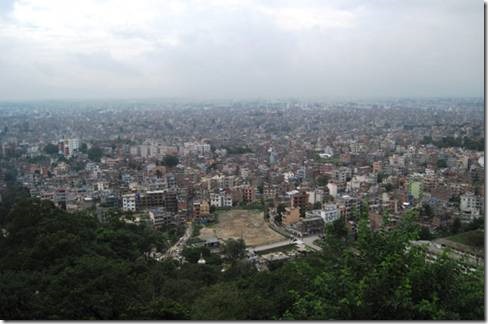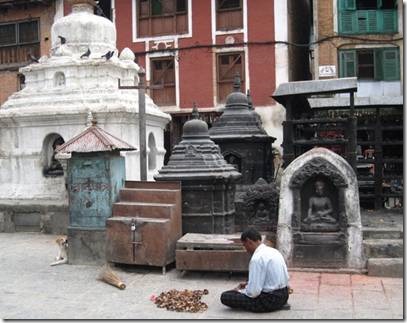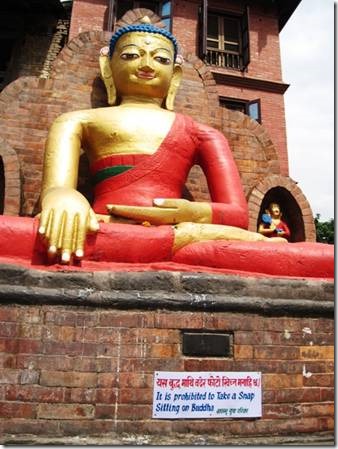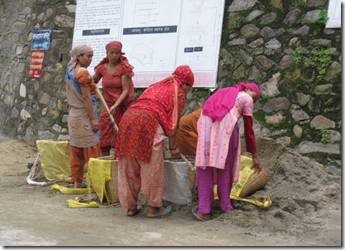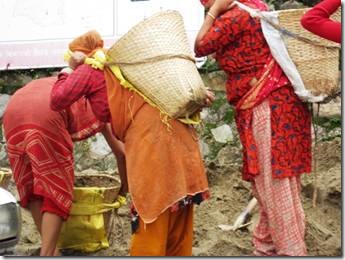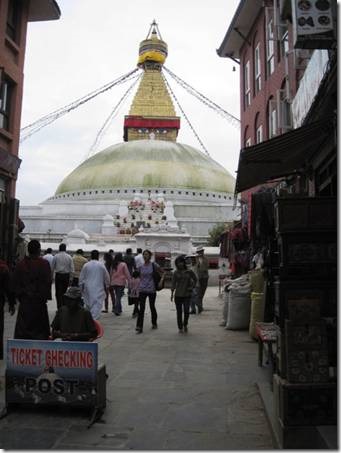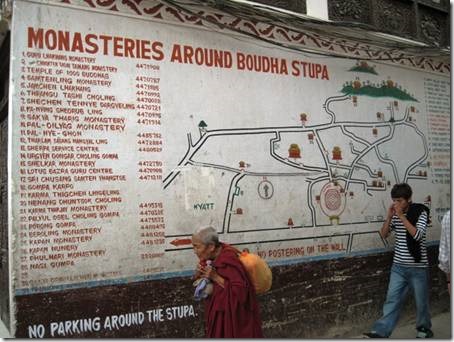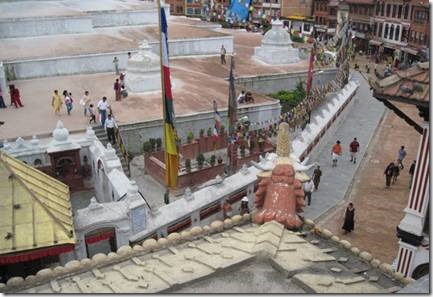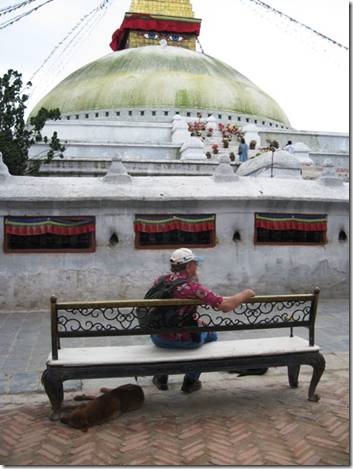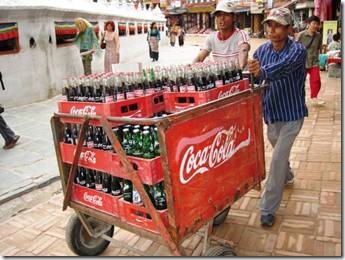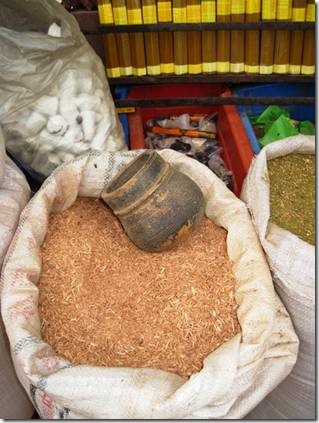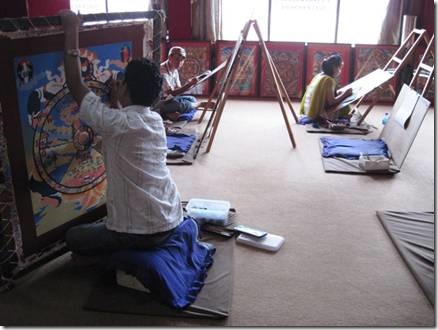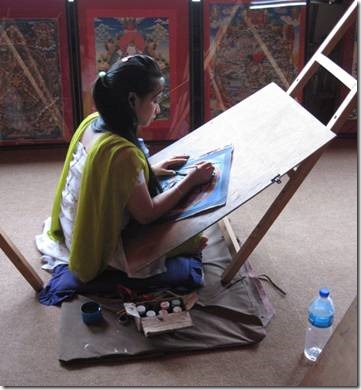Our time in Kathmandu was very short, just 3 full days. Our first day we toured some of the nearby Buddhist and Hindu sites. The second and third days we stayed around the small area of Thamel where streets are lined with small shops and restaurants and at least a dozen used book stores all catering to the bunches of western tourists who come there. Our hotel was located there and it was an easy place to spend a few days. The hotel was comfortable but it had no electric kettle and no hot water in the shower until about 7:30 am. And when Randal took a second shower late one afternoon, there also was very little hot water. We had a thermos in our room and when we called the front desk they would get it and fill it with hot water….as long as we wanted it after 7:30 am. We were only paying $40 per day so the fact that it had hot water at all…. Ronnie and David started out at a youth hostel for about $2 per day but only stayed one night; something about too many bugs…
While writing my email I reread David and Ronnie’s page about Nepal. It was a reminder about how colorful, chaotic, energetic and very poor Nepal is. And that Nepal is home to 8 of the 10 highest mountains in the world. Lots of people go there to trek and there are zillions of trekking advertisements up and down the streets of Thamel.
Especially after Tibet, Randal and I found Kathmandu very hot and between us had very little need to see any more Buddhist temples. And though our guide was very nice and undoubtedly needed to earn money, his English was really hard to understand so there wasn’t the rapport with him that we’d had with Lobsang in Tibet or our guide Rusli back in Tana Toraja in Indonesia. But, what there is to see fairly close to Kathmandu are Buddhist temples so that’s where we went. And also to a Hindu temple which was quite interesting.
The view from Monkey Temple
Our first stop was “the Monkey Temple” located up on a hill not very far from Thamel. It’s called Monkey Temple because once you saw lots of monkeys there. We saw about a dozen which seems like nothing compared to the gangs of them back at Sebana Cove and Rebak. Swayambhunath is the real name. “Swayambhunath, one of the most important cultural and historical place of Kingdom of Nepal and listed as one of the World Heritage Sites from 1978, is located about 2 km. to the West of Kathmandu. “ http://www.multinepal.com/swayambhu/index.html
There were people praying, but most people had come earlier in the morning before work.
I didn’t see the vibrancy here that I did in Tibet. It was as if the sun had bleached all of the color and energy. Maybe we had just visited enough Buddhist temples in Tibet that we just weren’t interested.
“It is prohibited to Take a Snap Sitting on the Buddha.”
More working women just like the ones in Tibet
We left the Monkey Temple which had few but very well behaved monkeys and drove through the dusty crowded streets of Kathmandu to our next stop, Boudhanath.
The dome of the Boudhanath stupa is 120 ft. in diameter, 107,639 sq. ft. in width, and141 ft. tall.
“The Great Stupa of Boudhanath stands approximately 6 km North East from the centre of Kathmandu valley….It is one of the most important place of pilgrimage for the Buddhist. In the past, when the trade routes to central and western Tibet were fully open, traders, pilgrims and travelers sought blessings at the stupa for safe passage over the mountain passes and gave thanksgiving to it upon arrival in the Kathmandu Valley. Today is towers over a small Tamang village that since the arrival of Tibetan refugees in the 1960s has become the centre of a thriving town of monasteries, craftsmanship and businesses. “
From the brochure we got with our ticket into the area though I’m really not sure how they keep people out with all of the shops lining the area, but we bought tickets.
Looking down from the roof of the temple across the way.
People circumambulate the stupa, many turning the thousands of prayer wheels that are set into the wall lining the walk. Around the outside are shops and restaurants and it’s a very lively area similar to Thamel. It kind of reminded me of the plazas in Italy!
Randal and friend under the watchful eyes of the Buddha.
While he was sitting here, Randal met the group of students and the professor from Virginia Tech who guessed that he was from Bedford.
Supplies for the restaurants and bars that surround the plaza.
You can see the woman in green turning some of the thousands of prayer wheels along the path.
I’m not sure what this is; I just liked the mug used to scoop it out.
Thangka artists.
We passed a shop and our guide took me in while Randal sat on his bench. The shop was downstairs and the gallery and studio upstairs.
http://www.tibetanpaintings.com/thangka-painting.htm offers a good description and explanation of Thangka. “A thangka may portray the Buddha or some other deity, or a concept in Tibetan cosmology, astrology or medicine. The iconography of the thangka is rich in information about the spiritual practice of Buddhists and the Tibetan worldview. …… A spiritual and religious expression as much as an art form, the process of learning to paint thangkas is rigorous. In the first three years, students learn to sketch the Tibetan Buddhist deities using precise grids dictated by scripture. The two years following are devoted to the techniques of grinding and applying the mineral colours and pure gold used in the paintings. In the sixth year, students study in detail the religious texts and scriptures used for the subject matter of their work. To become an accomplished thangka painter, at least ten years training is required under the constant supervision of a master. After the training process, students still need five to ten years to become experts in the field.”
The owner of this shop took the time to explain some of the aspects of the actual painting process to me. He knew I wasn’t there to buy because I told him right away. Because we had spent so much time in monasteries I couldn’t just look at the Thangka as art and didn’t want to buy it as a religious object. And the really nice ones, once he showed me how to see the differences, were too expensive and not something we’d want to put on a boat or leave rolled up for years. But he was very kind and liked to share his knowledge. He was Chinese so I told him about our Chinese boat and he said that he was on his way to LA for an art show.

